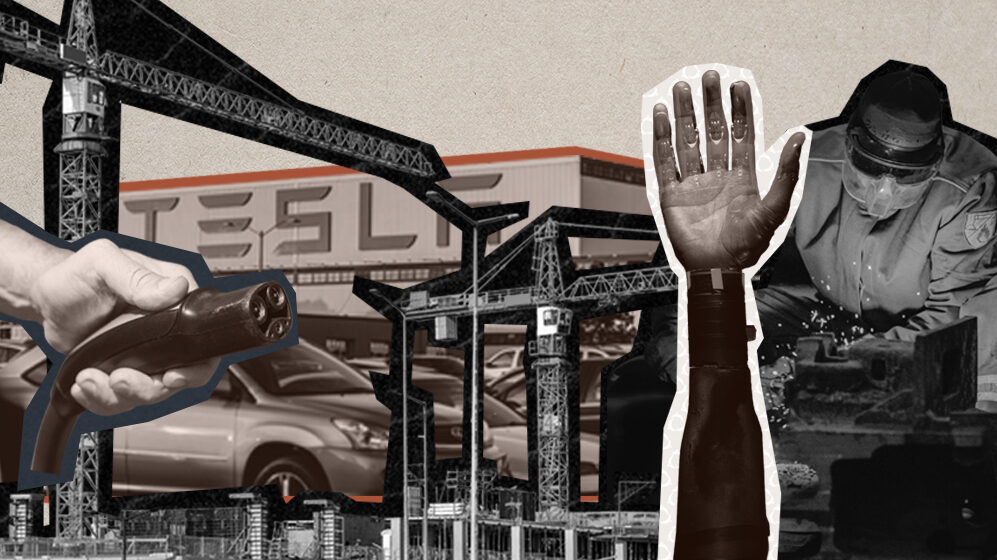Manufacturing operations must constantly evolve in order to maintain efficiency, competitive advantage, and even feasibility. But at what pace should innovation occur? And in which direction? How can the popular wisdom advising businesses to ‘lead, follow, or get out of the way’ be reconciled with the old adage ‘if it ain’t broke, don’t fix it’?
Tesla, Berlin, and the Car Factory of the Future
The name Elon Musk is nearly synonymous with innovation, a reputation the Tesla CEO hopes to bolster when the auto company’s new factory near Berlin opens. The facility will boast eight machines, each as long as a semitrailer and as tall as a two story home, to produce front and rear body parts for its vehicles, using single pieces of metal.1
“With our giant casting machines, we are literally trying to make full-size cars in the same way that toy cars are made,” read a January tweet from the polarizing mogul.
The new process aims to increase manufacturing productivity, decrease the weight of the vehicle, and increase driving range. Such a bold move has created a buzz, drawing the inevitable comparisons to Henry Ford.
“The big picture here is that Tesla has the opportunity to completely reinvent the car manufacturing process for vehicle production and factories,” writes Adam Jonas, Morgan Stanley’s top auto analyst. “Tesla is building the car factory of the future.”1
Risk and Reward in Production Innovation
Not everyone shares Musk’s appetite for risk, nor his deep pockets. While Musk may provide inspiration, he also presents a cautionary tale; Tesla’s ramp up to Model 3 suffered from an over-reliance on automation within his self-described ‘alien dreadnought’ factory concept.
Undeterred, Tesla looks to the future with the Berlin factory, capturing the attention of their rivals in the process.
“If it works, maybe it’s something we’d consider,” admits BMW AG’s production chief Milan Nedeljkovic.1
Clearly most companies prefer to know the line between leading edge and bleeding edge. David B. Marsing summarizes the conundrum in ‘Manufacturing Systems: Foundations of a World-Class Practice’.
“One of the biggest pitfalls of a company enjoying a particular market and product dominance is the tendency to avoid risk. This is a particularly serious challenge for those companies, because continuous improvements in manufacturing operations are one of the most effective means of creating and maintaining competitive advantage.”2
The Imperative of Updating Operating Processes
Updating manufacturing processes (or any process) currently means doing so during a period of rapid technological growth, unsteady supply chains, a ‘green revolution’, and a shaky regulatory/political climate. It’s costly, both in terms of time and capital.
It’s also an imperative. Modernizing machinery and systems allows for greater productivity, a safer work environment, and less risk of downtime due to unplanned maintenance.
“The sooner upgrades are implemented, the better their benefits can be recognized– and those upgrades will eventually become necessary just to keep up with the competition,” writes Jeremy Wright, Director of Product Management at Advanced Technology Services.”3
Lisa Caldwell argues for bold action from boards.
“Streamlining and discipline have been superseded by resilience and experimentation,” she writes for Forbes. “Technology and flexible working are recalibrating the workforce. Company boards and executive teams have to transform. That’s not to say manufacturers should throw the baby out with the bathwater.”4
Factors to Consider When Updating Manufacturing Processes
While most manufacturing operations won’t feel the need to revolutionize their facilities at the pace Tesla favours, they will want to avoid getting behind the 8-ball by modernizing both systems and machinery on a constant basis. Best results are achieved when decisions are carefully analyzed, with consideration for industry, company objectives, and all other relevant factors.
The more information that’s collected, the more informed these decisions will be. Technology should be leveraged for it’s data-collection capabilities, and all involved parties should be consulted. This means open lines of communication between management, those on the floor, and everybody in between.
When changes are implemented, they should be rolled out very carefully, with an appropriate amount of training and reference resources. It goes without saying that time for adaptation should be built into the equation.
Manufacturing Grants in British Columbia
Small and medium-sized manufacturers in British Columbia who are looking to expand, adapt and enhance their operations can do so with the help of the Stronger BC Accelerating Manufacturing Grants program.5
The program seeks to boost the manufacturing industry in British Columbia through innovation.
Victoria companies RaceRocks 3D and Iris Dynamics are utilizing the grant to “increase manufacturing capacity … for a new type of motion system based on a proprietary magnetic linear motor design”.5 The system will be used for simulation training and motion control and serves as an example of the type of innovative manufacturing being done right here in British Columbia.
Ultimately every company must take a holistic view of their operation when considering upgrades. Decisions should be measured and informed. Failure to address the challenge will inevitably result in dire consequences.




